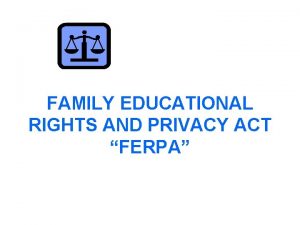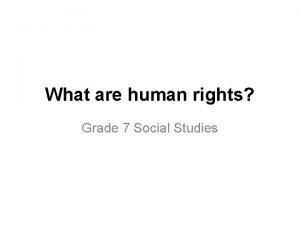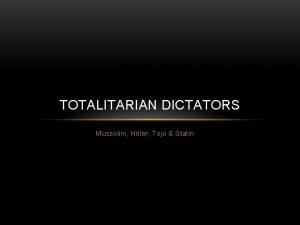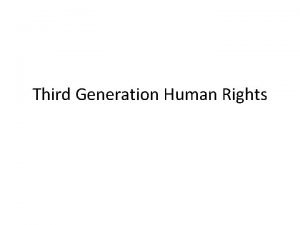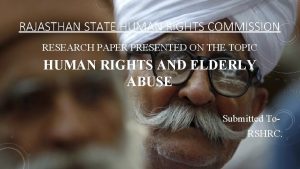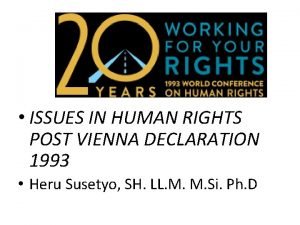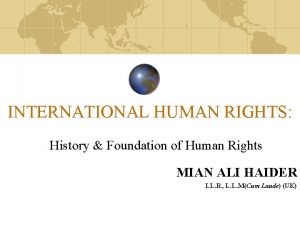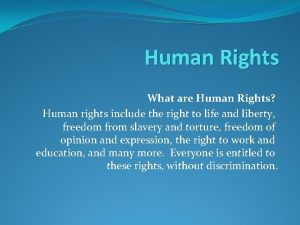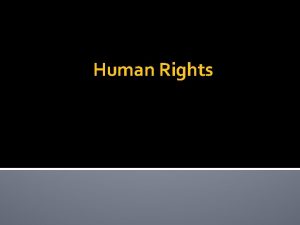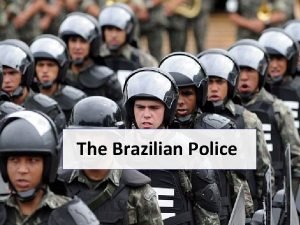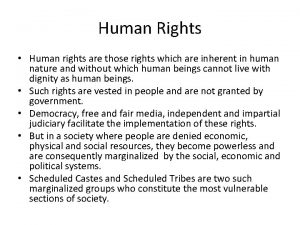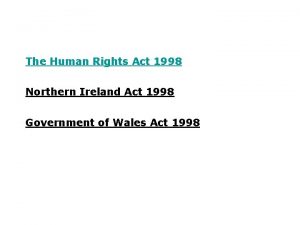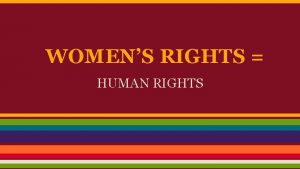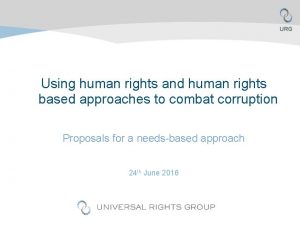THE HUMAN RIGHTS ACT AND THE UK POLICE























- Slides: 23

THE HUMAN RIGHTS ACT AND THE UK POLICE SERVICE

BEST PRACTICE IS MY ACTION • • LAWFUL? NECESSARY & JUSTIFIABLE? PROPORTIONATE? NON-DISCRIMINATORY?

The European Convention on Human Rights • was drafted in 1950 • was signed by UK but not incorporated into UK domestic law • 1966 UK individuals given right to take alleged breaches to the European Court

The Human Rights Act 1998 • received Royal Assent in November 1998 • came into force 2 nd October 2000

The aim of the Human Rights Act 1998 • to incorporate the European Convention of Human Rights and Fundamental Freedoms into UK domestic law

The European Convention on Human Rights • 20% of ECHR are from the UK • 95% of all cases are inadmissible • 75% of which are judged as ‘manifestly ill-founded’

Convention Rights • Article 2 - right to life • Article 3 - prohibition of torture • Article 4 - prohibition of slavery and forced labour • Article 5 - right to liberty and security • Article 6 - right to a fair trial • Article 7 - no punishment without law (no retrospective law)

Convention Rights • Article 8 - right to respect for private and family life • Article 9 - freedom of thought, conscience and religion • Article 10 - freedom of expression • Article 11 - freedom of assembly and association

Convention Rights • Article 12 - right to marry • Article 14 - prohibition of discrimination • Article 16 - restrictions on political activity of aliens • Article 17 - prohibition of the abuse of rights • Article 18 - limitation on use of restrictions on rights

Categories of rights • Articles 2, 3, 4, 5, 6 and 7 – the state cannot interfere with these in the public interest • Articles 8, 9, 10, and 11 – general public interest can be taken into account allowing the state to interfere

Public Authorities • Section 6 (1) and (2) of the Act – makes it unlawful for a ‘public authority’ to act incompatibly with the Convention – allows a ‘public authority’ to act incompatibly if domestic legislation cannot be interpreted compatibly

What is a Public Authority? • a court or tribunal, and • any person certain of whose functions are functions of a public nature (s 6)

DOCTRINES • • LAWFUL NECESSARY & JUSTIFIABLE PROPORTIONATE NON-DISCRIMINATORY EQUALITY OF ARMS MARGIN OF APPRECIATION POSITIVE OBLIGATION

LEGALITY The ‘law’ referred to is domestic law which must be: • identified and established • accessible (written down and available) and • formulated with sufficient clarity to be foreseeable in its consequences

NECESSITY • IS THE RESTRICTION ‘NECESSARY IN A DEMOCRATIC SOCIETY’? • IS THE RESTRICTION LEGITIMATE?

PROPORTIONALITY • FAIR BALANCE BETWEEN INDIVIDUAL RIGHTS & THE INTERESTS OF THE COMMUNITY. • THE INDIVIDUAL RIGHTS PROPORTIONAL TO THE LEGITIMATE AIM PURSUED. (not a sledgehammer to crack a nut)

EQUALITY OF ARMS • IN TRAIL PROCESS, DEF. MUST HAVE SAME INFORMATION & ACCESS TO INFORMATION AS THE POLICE/PROECUTION • APPLIES TO BOTH CRIMINAL AND CIVIL CASES

MARGIN OF APPRECIATION • the State is in a better position to decide domestic ‘necessity’ than an international court

POSITIVE OBLIGATIONS • State cannot refrain from interfering with people’s Convention Rights. • Duty to protect them.

VICTIMS • Victim of an unlawful act • would be victim of an unlawful act

HOW WILL VICTIMS BE ABLE TO USE THE CONVENTION IN OUR COURTS? Individuals who believe their rights have been infringed can rely on the Convention: • • as a defence in criminal proceedings as a basis of an appeal to seek judicial review to bring civil proceedings for damages

WHAT MIGHT HAPPEN IN COURT IF INFRINGEMENT IS FOUND TO BE UNJUSTIFIED? • proceedings stayed for abuse of process • evidence ruled inadmissible • indictments and convictions quashed • compensation awarded (where the court is able to do so)

BEST PRACTICE IS MY ACTION • • LAWFUL? NECESSARY & JUSTIFIABLE? PROPORTIONATE? NON-DISCRIMINATORY? • DO NOT FORGET - RECORD THE THOUGHT PROCESS
 Positive vs negative rights
Positive vs negative rights Legal rights and moral rights
Legal rights and moral rights Legal rights and moral rights
Legal rights and moral rights Negative right
Negative right Consequent passion and antecedent passion
Consequent passion and antecedent passion Littorial rights
Littorial rights What is negative right
What is negative right Negative right
Negative right Positive vs negative rights
Positive vs negative rights Direct voluntariness example
Direct voluntariness example Macbeth summary
Macbeth summary Define campaign in life orientation
Define campaign in life orientation Define human rights
Define human rights Family educational rights and privacy act 1974
Family educational rights and privacy act 1974 Family educational rights and privacy act of 1974
Family educational rights and privacy act of 1974 Mansfield act 120
Mansfield act 120 What is rights in social studies
What is rights in social studies What evidence do you see of hitler being nationalistic
What evidence do you see of hitler being nationalistic First generation of rights
First generation of rights Theories of human rights
Theories of human rights Global regents thematic essay topics
Global regents thematic essay topics State human right commission rajasthan
State human right commission rajasthan Vienna declaration of human rights
Vienna declaration of human rights Meaning of human rights
Meaning of human rights













